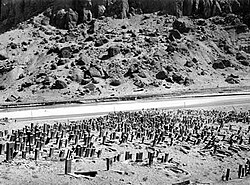| Armenian cemetery in Julfa | |
|---|---|
 The cemetery at Julfa as seen in a photograph taken in 1915 by Aram Vruyrian.  | |
 | |
| Details | |
| Location | Julfa, Nakhchivan Autonomous Republic, Azerbaijan |
| Coordinates | 38°58′27″N 45°33′53″E / 38.974172°N 45.564803°E |
| Type | public |
| No. of graves | 1648: 10,000 1903–04: 5,000 1998: 2,700 2006: 0 |
The Armenian cemetery in Julfa (Armenian: Ջուղայի գերեզմանատուն, Jughayi gerezmanatun)[1] was a cemetery near the town of Julfa (known as Jugha in Armenian), in the Nakhchivan exclave of Azerbaijan that originally housed around 10,000 funerary monuments.[2] The tombstones consisted mainly of thousands of khachkars—uniquely decorated cross-stones characteristic of medieval Christian Armenian art. The cemetery was still standing in the late 1990s, when the government of Azerbaijan began a systemic campaign to destroy the monuments.
Several appeals were filed by both Armenian and international organizations, condemning the Azerbaijani government and calling on it to desist from such activity. In 2006, Azerbaijan barred European Parliament members from investigating the claims, charging them with a "biased and hysterical approach" to the issue and stating that it would only accept a delegation if it visited Armenian-occupied territory as well.[3] In the spring of 2006, a journalist from the Institute for War and Peace Reporting who visited the area reported that no visible traces of the cemetery remained.[4] In the same year, photographs taken from Iran showed that the cemetery site had been turned into a military shooting range.[5] The destruction of the cemetery has been widely described by Armenian sources, and some non-Armenian sources, as an act of cultural genocide.[6][7][8]
After studying and comparing satellite photos of Julfa taken in 2003 and 2009, in December 2010 the American Association for the Advancement of Science came to the conclusion that the cemetery was demolished and leveled.[9]
- ^ Aivazian, Argam (1983). "Ջուղայի գերեզմանատուն (The Cemetery of Jugha)". Armenian Soviet Encyclopedia Volume IX. Yerevan: Armenian Academy of Sciences. p. 550.
- ^ Cite error: The named reference
Pickmanwas invoked but never defined (see the help page). - ^ Castle, Stephen (23 October 2011). "Azerbaijan 'flattened' sacred Armenian site". The Independent.
- ^ Abbasov, Idrak; Rzayev, Shahin; Mamedov, Jasur; Muradian, Seda; Avetian, Narine; Ter-Sahakian, Karine (27 April 2006). "Azerbaijan: Famous Medieval Cemetery Vanishes". Institute for War and Peace Reporting.
- ^ Maghakyan, Simon (November 2007). "Sacred Stones Silenced in Azerbaijan". History Today. 57 (11): 4–5.
- ^ Antonyan, Yulia; Siekierski, Konrad (2014). "A neopagan movement in Armenia: the children of Ara". In Aitamurto, Kaarina; Simpson, Scott (eds.). Modern Pagan and Native Faith Movements in Central and Eastern Europe. Routledge. p. 280.
By analogy, other tragic events or threatening processes are designated today by Armenians as "cultural genocide" (for example, the destruction by Azerbaijanis of the Armenian cemetery in Julfa)...
- ^ Ghazinyan, Aris (13 January 2006). "Cultural War: Systematic destruction of Old Julfa khachkars raises international attention". ArmeniaNow. Archived from the original on 25 November 2015. Retrieved 24 November 2015.
...another "cultural genocide being perpetrated by Azerbaijan."
- ^ Uğur Ümit Üngör (2015). "Cultural genocide: Destruction of material and non-material human culture". In Carmichael, Cathie; Maguire, Richard C. (eds.). The Routledge History of Genocide. Routledge. p. 250. ISBN 9781317514848.
- ^ "High-Resolution Satellite Imagery and the Destruction of Cultural Artifacts in Nakhchivan, Azerbaijan". American Association for the Advancement of Science. 8 December 2010.